

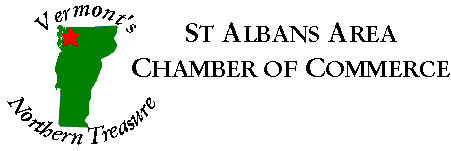
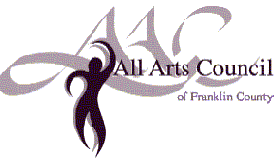


The Artistry of Space collection reflects the excitement and energy of space exploration. It will visit Franklin County, Vermont, on Artrain USA.
Since the inception of NASA's Art Program in 1962, NASA has invited more than 250 American artists to be involved in the U.S. space programs and to interpret space flight through art. In a creative melding of art and space, the artists, responding to space exploration on emotional and spiritual levels, documented the work of engineers, astronauts, and scientists. From the excitement of the initial effort to put a man on the moon to recent endeavors such as the Mars Pathfinder Mission and the Hubble Space Telescope, artists including Peter Max, Robert McCall, Robert Rauschenberg, Norman Rockwell, Andy Warhol and James Wyeth have captured the spirit of space exploration. Their paintings, drawings, prints and sketches will be part of our Franklin County Railroad Days Festival in St Albans, Vermont.
This page introduces some of the work in the collection and lists the artists.
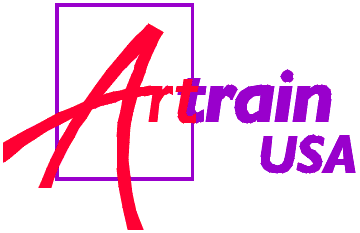
| Festival Home |
Railroad Days | Artrain USA | AAC Exhibit | AAC Home |
| History Tour | Artrain FAQ | Things to Do | ||
| Sponsors | School News | Maps |
| Vermont's Deborah Deschner Belly of the Bird Etching print on Paper, 1989 Reentry heat created subtle patterns on the protection tiles of the Space Shuttle Columbia. Using the etching process, Deschner echoed the tile surface with her acid-burned, metal printing plate.1 Used with permission of the artist |
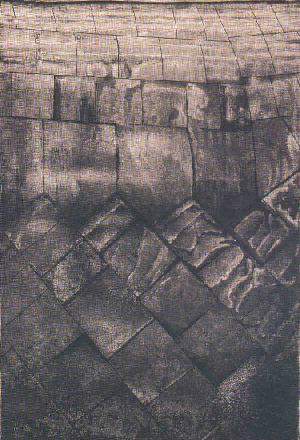 |
|
Jim Alford, Double X and Edge, 1992 Jane Ira Bloom, Rediscovery: STS-26, The Return to Flight, 1989 Chakaia Booker, Mars Rising, 1998 Paul Calle, Launch Morning, 1969 Power to Go, 1969 Henry Casselli, Astronaut Bob Crippen, Study 4, 1980 Connecting Gloves, 1980 John Glenn, 1999 John Glenn STS-95, 1999 When Thoughts Turn Inward, 1982 Alan Chinchar, Los Que Oien (The Listeners), 1989 Alan Cober, Apollo 16 Sketchbook, 1972 Hereward Lester Cooke, Man's First Landing on the Moon, 1969 Mario Ruben Cooper, Apollo 10-11 Sketchbook, 1969 James L. Cunningham, Imaging to the Edge of Space & Time, 1990 James Dean, Waiting for Jamie, 1969 Deborah E. Deschner, Belly of the Bird, 1989 Lamar Dodd, The Second Giant Step, 1981 Watching (CBS Camera Set-Up), 1963 Linda Draper, Working in Space, 1994 Mary Edna Fraser, Amazon Rivers, 1997 Nathan Greene, Post Landing Convoy Operations, 1992 Theodore Hancock, Marshall Space Flight Center, 1964 The Sound of Engines, 1964 Attila Hejja, The Light Ship, 1984 Peter Hurd, Radar Antenna, Mercury Control Center Cape Canaveral, 1963 Wilson Hurley, Viking/Mars Encounter, 1991 Crystal Jackson, Food and Entertainment at Cocoa Beach, 1966 Scenes from the Cocoa Beach Area, 1966 Watching the Gemini 10 Launch Mitchell Jamieson, First Look, 1969 Chet Jezierski, Vacancy, 1982 Howard Koslow, Premiere Flight of Endeavour, 1993 Morton Kunstler, Tile Team, 1980 Pamela Lee, Bringing in the Big Boy, 1988 Peter Max, Man on the Moon, 1989 Robert McCall, Apollo Story Lithographs: First on the Moon Apollo Story Lithographs: Rendezvous Apollo Story Lithographs: Splashdown |
|
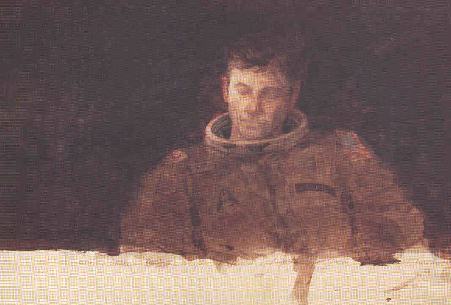 |
Henry Casselli When Thoughts Turn Inward NASA Art Program, drybrush watercolor on paper, 1982 This painting communicates the introspective sensitivity of astronaut John Young during suit-up for Columbia's launch on April 12, 1981. Young, sitting alone in his spacesuit, bows his head, deep in private thought. A muted color palette contributes to the quiet mood and personal moment captured by Casselli's portraiture.1 |
| Norman Rockwell Man's First Step on the Moon Oil on Canvas, 1966 © Norman Rockwell Family Trust In this painting commissioned by Look, a popular picture magazine, Norman Rockwell predicted with remarkable foresight the monumental event that would transpire years later on July 20, 1969, when Neil Armstrong became the first human to step on the Moon. Because of the magazine's popularity, the work was widely distributed, providing a vast number of Americans a tantalizing preview of the much-anticipated lunar landing.1 |
 |
|
John W. McCoy II, First Light, 1963
Greg Mort, Challenger in White, 1986 P.A. Nisbet, Go for the Stars, 1990 Andreas Nottebohm, Neptune and the Fire of Knowledge, 1990 Unexplainable Textures Emerging on Saturn, the 13th of October, 2044 , 1982 Tom O'Hara, Space Riders, 1969 Station 13, Collecting Rock Samples, 1972 The Drill, 1972 The Huge Mound, 1972 Jack Perlmutter, Flight of Columbia, 1981 Robert Rauschenberg, Stoned Moon Series: Earth Crust, 1969 Norman Rockwell, Man's First Step on the Moon, 1966 Charles Ross, Black Holes Make Me Think of Light, 1997 Paul Sample, Fire Crew After Saturn Launch, 1964 Neighbors, 1964 Pad 37, 1964 To the Moon, 1964 Lonny Schiff, Passing Through the Rings of Saturn, 1989 Satellite in Space, 1989 Charles Schmidt, Tiling the Space Shuttle Columbia Studies II, 1981 Robert Schulman, After Touchdown, 1981 Arthur Shilstone, Landing, 1981 Robert Shore, From the Inside, 1963 Gordon Cooper, 1963 Preflight, 1963 Howard Siskowitz, Discovery, 1984 Paradox, 1984 Redundancy, 1984 John Solie, Space Telescope Assembly, 1988 Nicholas Solovioff, The Last Apollo, 1972 Stephen Sprouse, NASA Rover Mars Pink, 1999/2000 Stan Stokes, X-15, 1986 Christian Vincent, Dreams, 1998 Andy Warhol, Moonwalk (1), 1987 Mindy Weisel, Out of the Unlit Earth: Celebrating Women in Space, 1998 George Weymouth, The Start, 1963 James Browning Wyeth, Apollo 11 One, Two, Three, 1969 Support, 1965 Tina York, Fluid Dynamics, 1995 |
|
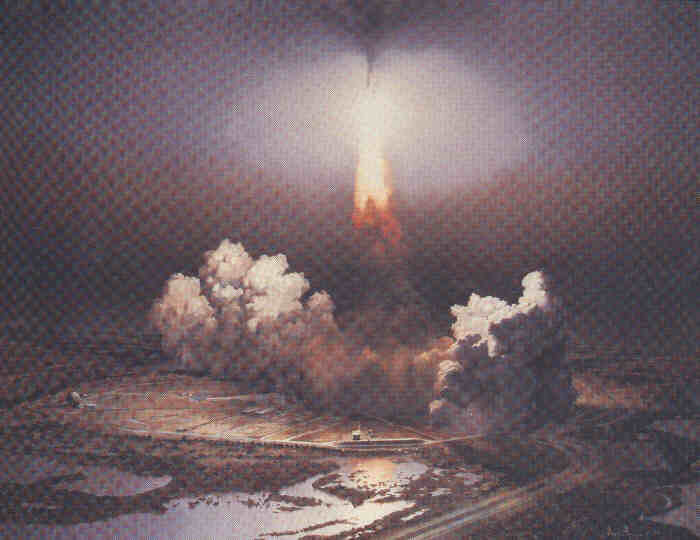 |
Atilla Hejja The Light Ship NASA Art Program, oil on masonite, 1984 Hejja protrays the first night launch of the Space Shuttle Challenger on August 30, 1983, in the grand style of American landscape painting, but from a dramatic aerial-view perspective. Kennedy Spaceport Center is spread out below the fiery column of a lifting Shuttle. Vapor clouds obscure the landscape, while other portions of it are lit by the rocket's trail.1 |
| Peter Max Man on the Moon Oil on Paper, 1989 © Peter Max, 1989 In his playful, pop-art style, Peter Max positions an astronaut of superhuman scale to stand on the orb of the moon as if he were a climber having scaled a mountain summit. By simplifying the elements of human and Moon into a heraldic device, Max evokes the triumph as well as the desolation of conquering the Earth's bleak satellite.1 |
 |
"The Artistry of Space exhibition is exciting, because it touches all generations and gives us the opportunity to bring museum art to the nation, while incorporating the relationship of art to science and technology," said Debra Polich, President and CEO of Artrain USA. "Artrain USA is about touching lives and opening doors for people and communities. For some children and adults, it's the first time they have had the experience of visiting an art museum."
Susan Lawson-Bell, Artrain USA'scurator, selected paintings, drawings, prints, and sketches from the NASA Art Collection for the Artistry of Space tour. From the excitement of the initial effort to put a man on the moon to recent endeavors such as the Mars Pathfinder Mission and the Hubble Space Telescope, these world renowned artists have captured the spirit of space. 
The artworks range from realistic to abstract, created in media such as oil, acrylic, pen and ink, watercolor and pencil.
See our Artrain FAQ and visit the Artrain USA web site for more information about the Artrain.

Dick Harper, Chair
P.O. Box 1
Highgate Springs, VT 05460
email us

| Festival Home |
Railroad Days | Artrain USA | AAC Exhibit | AAC Home |
| History Tour | Artrain FAQ | Things to Do | ||
| Sponsors | School News | Maps |
1 Descriptions of the artwork © Susan Lawson-Bell, curator, Artrain, 1999. Used with permission.